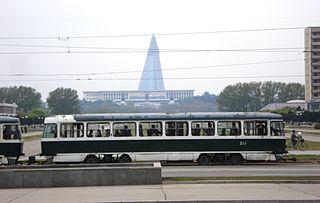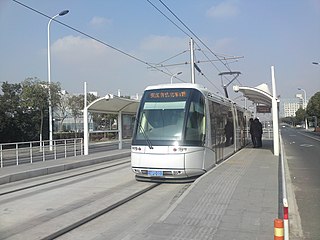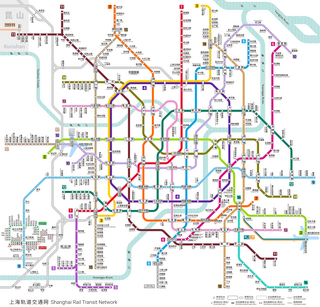
Dalian is a major sub-provincial port city in Liaoning province, People's Republic of China, and is Liaoning's second largest city and the third-most populous city of Northeast China. Located on the southern tip of the Liaodong peninsula, it is the southernmost city in both Liaoning and the entire Northeast. Dalian borders the prefectural cities of Yingkou and Anshan to the north and Dandong to the northeast, and also shares maritime boundaries with Qinhuangdao and Huludao across the Liaodong Bay to west and northwest, Yantai and Weihai on the Shandong peninsula across the Bohai Strait to the south, and North Korea across the Korea Bay to the east.

Hong Kong Tramways (HKT) is a 3 ft 6 in narrow-gauge tram system in Hong Kong. Owned and operated by RATP Dev, the tramway runs on Hong Kong Island between Kennedy Town and Shau Kei Wan, with a branch circulating through Happy Valley.

The Shanghai Public Transportation Card (SPTC) is a contactless card, utilizing RFID technology, which can be used to access many forms of public transport and related services in and around Shanghai. Shanghai public transportation card is also provided in the form of Apple Pay as well as QR codes, which is accessible through WeChat, Alipay, APPs and miniprograms, and enjoy same price discounts as cards.

Pyongyang Tram is a public tram system in Pyongyang, the capital of the North Korea. The first line of the current system opened in 1989. There are currently four lines in operation.

Trams and trolleybuses in North Korea are forms of public transportation for North Koreans to travel around in urban centres given the shortages on fuel and access to cars for average citizens.

The Dalian Metro is a rapid transit system in the city of Dalian, Liaoning, China. The metro system opened on 1 May 2003. The system currently in operation consists of 6 lines: Line 1, Line 2, Line 3, Line 5, Line 12, and Line 13.

The Vinnytsia Tramway network is the part of the public transportation system that since 1913 serves Vinnytsia, the administrative center of the Vinnytsia Oblast, Ukraine. The tram system has a narrow rail gauge of 1,000 mm that only exists in Ukraine in the cities of Lviv, Zhytomyr and Yevpatoria, as well as Vinnytsia. The system currently consists of 21.2 km of tracks.

Zhangjiang Tram was a tram network operating in Shanghai that utilised a Translohr system. Shanghai originally had a steel wheeled electric tramway network in its urban center. Routes expanded gradually and reached largest extent in 1925 with 328 tramcars; this tram system shut down in 1975. Tram service returned to Shanghai with the opening of a rubber tired Translohr line in the suburban Zhangjiang Hi-Tech Park in 2010. It is the second rubber-tired tram system in both China and Asia, the first being TEDA tram in Tianjin.

The Xijiao Line of the Beijing Subway, also called No. 29 Line is a light rail line in Haidian District of Beijing. It runs west and north from Bagou on Line 10 to the Xiangshan - a total length of 8.8 km (5.47 mi). It opened on 30 December 2017. The line is operated by Beijing Public Transit Tramway Co. Ltd. a subsidiary of Beijing Public Transport Holdings, Ltd. which runs Beijing's Buses.

The Moscow tramway network, which is divided into two sub-networks, is a key element of the public transport system in Moscow, the capital city of Russia. Opened in 1872, it has been operated since 1958 until 2021 by Mosgortrans, a state-owned company.

Dalian Hi-tech Zone or DHZ is an industrial district in the western suburbs of Dalian, Liaoning, China. It extends about 30 kilometres along Lüshun South Road and Guoshui Highway in Shahekou District and Lüshunkou District, where many of the world's multinational technology companies have operations.

The earliest tram (有轨电车) service in Beijing dates back to 1899, and trams were the main form of public transit from 1924 to the late 1950s before they were replaced by trolleybuses that follow the tram routes they replaced. However new tram services are being introduced in Beijing's suburbs.

Several cities in China had tram systems during the 20th century; however, by the end of the century, only Dalian and Changchun remained extant. However the 21st century has seen a resurgence in tram transport systems as China attempts to combat with urban traffic congestion and pollution.

Shenzhen has an extensive transport network, including various forms of land, water and air transport.

Shenyang Modern Tram is a tram network operating in Hunnan New District in southern Shenyang, Liaoning province, People's Republic of China. The tram system mostly uses a traditional overhead line system, but some sections are wireless with the tram running partly on super-capacitor batteries charging at every stop, the first such system in Asia. It is the longest tram system in China.
Trams in Wuhan may refer to any one of the tram systems currently operational in the city of Wuhan, Hubei, China. The first tram started revenue service in Wuhan is the Auto-city T1 Line, which began on July 28, 2017. Subsequently, Optics Valley tram started revenue service from April 1, 2018.

Songjiang Tram is a light rail tramway in Shanghai, China. The system consists of two lines totaling 31 km (19 mi) with 42 stations. Unlike the Zhangjiang Tram, Songjiang trams use centenary power supply and steel-wheeled rail systems. Most of them use independent rights of way. The intersection signal lights were adjusted through the system to make them pass first, and the running speed reaches 25-30km/h. Trains run from 6:00 till 22:00. With further extension of the network public transport modal split in Songjiang is expected from the current 23% to 40%.

Chengdu Tram Line 2 is a tram line in Chengdu, China. The line has a total length of 39.3 kilometres (24.4 mi) and 35 stations. It has a 'Y' layout and runs from the Chengdu West railway station to Pixian West railway station and Hongguang. The line was officially started in December 2015, and the 13.7 km (8.5 mi) demonstration section of the line was opened on 26 December 2018, and the remaining sections were opened on 27 December 2019.

Shanghai Rail Transit includes all rail transit lines operating in Shanghai, mainly composed of High-volume railway system, Low-to-medium-volume railway system and Maglev system. The system was established on May 28, 1993, when Shanghai Metro Line 1 opened.

The Kyiv Trolleybus is a trolleybus network in Kyiv, the largest trolleybus network in the world in terms of line length, and the largest in Ukraine in terms of length and number of cars. The network was opened on November 5, 1935.






















